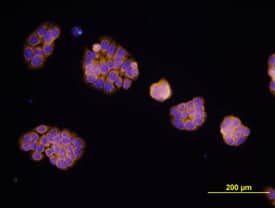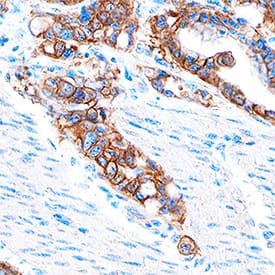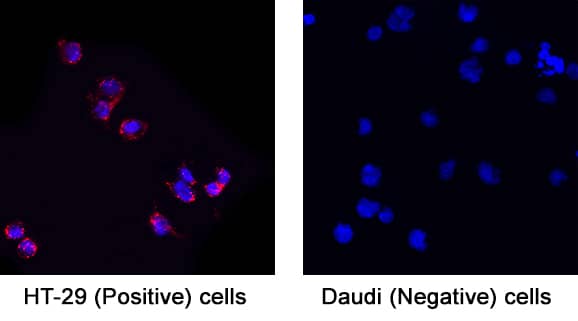Human
EpCAM/TROP-1 Antibody
R&D Systems, part of Bio-Techne | Catalog # MAB960


Key Product Details
Species Reactivity
Validated:
Cited:
Applications
Validated:
Cited:
Label
Antibody Source
Product Specifications
Immunogen
Gln24-Lys265
Accession # P16422
Specificity
Clonality
Host
Isotype
Scientific Data Images for Human EpCAM/TROP-1 Antibody
Detection of EpCAM/TROP-1 in Human Colon via Multiplex Immunofluorescence staining on COMET™
EpCAM/TROP-1 was detected in immersion fixed paraffin-embedded sections of human colon using Mouse Anti-Human EpCAM/TROP-1 Monoclonal Antibody (MAB960) at 1µg/mL at 37 ° Celsius for 4 minutes. Before incubation with the primary antibody, tissue underwent an all-in-one dewaxing and antigen retrieval preprocessing using PreTreatment Module (PT Module) and Dewax and HIER Buffer H (pH 9). Tissue was stained using the Alexa Fluor™ 647 Goat anti-Mouse IgG Secondary Antibody at 1:200 at 37 ° Celsius for 2 minutes. (Yellow; Lunaphore Catalog # DR647MS) and counterstained with DAPI (blue; Lunaphore Catalog # DR100). Specific staining was localized to the membrane. Protocol available in COMET™ Panel Builder.EpCAM/TROP-1 in HT-29 Human Cell Line.
EpCAM/TROP-1 was detected in immersion fixed HT-29 human colon adenocarcinoma cell line using Mouse Anti-Human EpCAM/TROP-1 Monoclonal Antibody (Catalog # MAB960) at 10 µg/mL for 3 hours at room temperature. Cells were stained using the NorthernLights™ 493-conjugated Anti-Mouse IgG Secondary Antibody (green; NL009) and counterstained with DAPI (blue). View our protocol for Fluorescent ICC Staining of Cells on Coverslips.EpCAM/TROP‑1 in HT-29 Human Cell Line.
EpCAM/TROP-1 was detected in immersion fixed HT-29 human colon adenocarcinoma cell line using Mouse Anti-Human EpCAM/TROP-1 Monoclonal Antibody (Catalog # MAB960) at 10 µg/mL for 3 hours at room temperature. Cells were stained using the NorthernLights™ 557-conjugated Anti-Mouse IgG Secondary Antibody (yellow; NL007) and counterstained with DAPI (blue). View our protocol for Fluorescent ICC Staining of Cells on Coverslips.Applications for Human EpCAM/TROP-1 Antibody
Immunocytochemistry
Sample: Immersion fixed HT‑29 human colon adenocarcinoma cell line (positive) and Daudi human Burkitt's lymphoma cell line (negative) cells
Immunohistochemistry
Sample: Immersion fixed paraffin-embedded sections of human adenocarcinoma
Multiplex Immunofluorescence
Sample: Immersion fixed paraffin-embedded sections of human colon
Western Blot
Sample: Recombinant Human EpCAM/TROP-1 Fc Chimera (Catalog # 960-EP)
Reviewed Applications
Read 2 reviews rated 4.5 using MAB960 in the following applications:
Formulation, Preparation, and Storage
Purification
Reconstitution
Formulation
*Small pack size (-SP) is supplied either lyophilized or as a 0.2 µm filtered solution in PBS.
Shipping
Stability & Storage
- 12 months from date of receipt, -20 to -70 °C as supplied.
- 1 month, 2 to 8 °C under sterile conditions after reconstitution.
- 6 months, -20 to -70 °C under sterile conditions after reconstitution.
Background: EpCAM/TROP1
Epithelial Cellular Adhesion Molecule (EpCAM), also known as KS1/4, gp40, GA733-2, 17-1A, and TROP-1, is a 40 kDa transmembrane glycoprotein composed of a 242 amino acid (aa) extracellular domain with two epidermal-growth-factor-like (EGF-like) repeats within the cysteine-rich N-terminal region, a 23 aa transmembrane domain, and a 26 aa cytoplasmic domain. Human and mouse EpCAM share 82% aa sequence identity. In human, EpCAM also shares 49% aa sequence homology with Trop-2/EGP-1. During embryonic development, EpCAM is detected in fetal lung, kidney, liver, pancreas, skin, and germ cells. In adults, human EpCAM is detected in basolateral cell membranes of all simple, pseudo-stratified, and transitional epithelia, but is not detected in normal squamous stratified epithelia, mesenchymal tissue, muscular tissue, neuro-endocrine tissue, or lymphoid tissue (1). EpCAM expression has been found to increase in actively proliferating epithelia tissues and during adult liver regeneration (1, 2). EpCAM expression is also found to increase in human malignant neoplasias, with most carcinoma expressing EpCAM including those of arising from squamousal epithelia (1). EpCAM has been shown function as a homophilic Ca2+ independent adhesion molecule (3). Homophilic adhesion via EpCAM requires the interaction of both EGF-like repeats, with the first EGF-like repeat mediating reciprocal interaction between EpCAM molecules on opposing cells, while the second repeat is involved in lateral interaction of EpCAM. Lateral interaction of EpCAM lead to the formation of dimers and tetramers (4). During homophilic adhesion the cytoplasmic tail of EpCAM interacts with the actin cytoskeleton via a direct association alpha-actinin (5).
References
- Balzar, M. et al. (1999) J. Mol. Med. 77:699.
- Boer, C.J. et al. (1999) J. Pathol. 188:201.
- Litvinow, S.V. et al. (1994) J. Cell Biol. 125:437.
- Balzar, M. et al. (2001) Mol. Cell. Biol. 21:2570.
- Balzar, M. et al. (1998) Mol. Cell. Biol. 18:4388.
Long Name
Alternate Names
Gene Symbol
UniProt
Additional EpCAM/TROP1 Products
Product Documents for Human EpCAM/TROP-1 Antibody
Product Specific Notices for Human EpCAM/TROP-1 Antibody
For research use only



